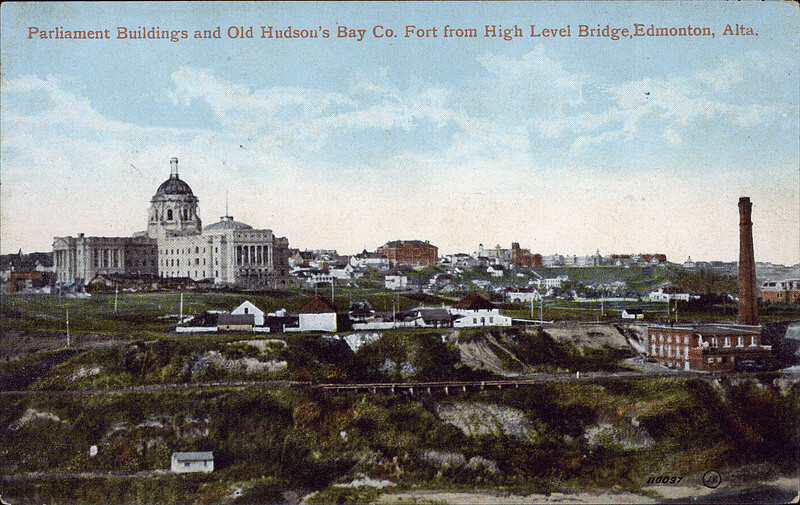
The Original Fort Edmonton Park
We get asked this a lot. So we turned to public historian and four-year veteran interpreter Lauren Markewicz to break it down!
This is one of the most frequently asked questions by visitors to the park: “Is this the original fort?”
It’s a fair question. The wood of the fort at Fort Edmonton Park looks quite old. The park also has numerous original buildings on site which have been moved there from their original locations over the past decades. Unfortunately, the answer is no, the original fort is not on site.
“Where is/was the original fort?” is often the follow-up question.
The answer? It’s complicated.
Fort Edmonton was nominally founded in 1795 (alongside a few short-lived North-West Company posts by the name of Fort Augustus), but no structure by the name of Fort Edmonton stood for more than a decade or so in the same location until the fifth and final fort was constructed in 1840. They were built either too far away for local customers to conveniently visit (e.g., the location that was near modern Fort Saskatchewan) or in a location prone to flooding, like the two times it was placed near the Rossdale Flats. They were also never meant to be permanent structures and were not designed to stand the test of time.
You can still see faint evidence of the fourth fort now: right next to the old fort cemetery, on the North side of the Walterdale Bridge, where they have graves, a statue, and interpretive signs. I have been told that the fort stood on the big flat square that is now the intersection of 95 Ave and 105 street NW. According to our records and archaeological digs, numerous individuals from the early history of the Fort are buried there next to the intersection, including Nancy Harriott, one of the daughters of Fort Edmonton’s Chief Factor John Rowand.
This still has not answered your original question: where is the original fort, the one represented at Fort Edmonton? The fifth and final one? Well, they had trouble with flooding in earlier iterations, so they moved the location of the fort up the hill… to a very familiar hill, in fact, if you live in Edmonton today. Let’s go to Google Maps:
View Larger Map
This is a map showing the grounds of the Alberta Legislature building in Edmonton, which houses the provincial government of Alberta. In behind the Legislature is a set of stairs: go down them. At the bottom, you’ll find a lovely flat area where they do lawn bowling today: a square of cleared land. That green square is where the original fort stood.
If you visit the site, you will see little obelisks set up where some of the old bastions used to be. There’s also the photographic record, because Edmontonians and tourists to the city loved seeing the contrast between old (the fort) and new (the construction of the high level bridge and the Legislature) on postcards of the era. The Legislature shared the grounds with the fort for nearly a decade in the early twentieth century.

POSTCARD 7081
PARLIAMENT BUILDINGS AND OLD HUDSON’S BAY CO. FORT FROM HIGH LEVEL BRIDGE, EDMONTON, ALTA. MONTREAL: TORONTO: WINNIPEG: VANCOUVER: THE VALENTINE & SONS PUBLISHING CO., LTD., [AFTER 1907]. COURTESY OF PEEL’S PRAIRIE PROVINCES.

POSTCARD 7080
OLD HUDSON BAY POST AND PARLIAMENT BLDG., EDMONTON, ALTA. EDMONTON: PUB. FOR LEONARDS CIGAR STORE, PANTAGES THEATRE BLDG., EDMONTON, ALTA, [AFTER 1913]. COURTESY OF PEEL’S PRAIRIE PROVINCES.

PC006361.14
HIGH LEVEL BRIDGE AT EDMONTON FOR CANADIAN PACIFIC RY. AND GENERAL TRAFFIC. WINNIPEG: PUBLISHED BY THE CANADIAN PROMOTION CO. 415 ASHDOWN BLDG., WINNIPEG, [1913]. COURTESY OF PEEL’S PRAIRIE PROVINCES.
The old fort wasn’t torn down entirely until 1915, though previously the tall walls had been removed and the wooden buildings whitewashed. It had looked more or less like it was portrayed on this postcard for over a generation.
Why was it torn down, if it is such an important part of Edmonton’s history? By the first decade of the twentieth century, it wasn’t in the best of shape. The fur trade had been in decline in the area since the 1860s and the fort’s buildings had been mostly abandoned for several decades after being used as a warehouse. Photographs of the era show the buildings to be listing rather severely to one side. The company no longer owned the land, and in all honesty, the buildings were probably spoiling the view of the grounds from the legislature building. It was rotting and reportedly full of vermin, so it was torn down.
The reconstruction of the fort at Fort Edmonton Park, while made to the exact measurements of the Palliser plan from 1846, is different in a handful of ways from the original fort, but most significantly is this: it is a mirror image of the original fort. Why? The old one was on the North side of the North Saskatchewan River. The park stands on the South side. The gates had to face in the correct direction: the river.
One more fun fact to leave you with: while not the original fort, the reconstruction at Fort Edmonton Park has been in use longer than any of the individual original forts of the past – and probably remains in far better shape. Furthermore, I can almost guarantee you that the modern reconstruction smells better than the original, because nowhere near as many furs are being tanned or meat is being dried. You can’t smell the modern fort from miles around, unlike the originals, for which I am certain the public is grateful.
Lauren Markewicz is a four-year veteran interpreter of Fort Edmonton Park, currently pursuing a Master’s Degree in Public History at Carleton University in Ottawa, Ontario.